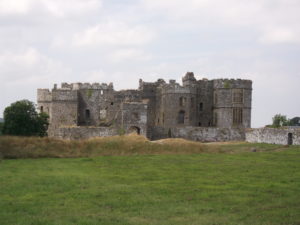As a medievalist and a mastiff owner, it seems fitting that I first found my beloved dogs in the pages of medieval literature, specifically in Geoffrey Chaucer’s Canterbury Tales.
In Chaucer’s Knight’s Tale, Palamon and Arcite are pitted against one another in a tournament to determine which knight will win Emelye’s hand in marriage. The contestants are given a year to prepare, during which time they each assemble an entourage of men to accompany them into the melee. When the Knight introduces Lycurgus, “the grete king of Trace” [the great king of Thrace] (Chaucer 2129) who sides with Palamon, he describes the dogs circling his chariot as part of the tournament’s pageantry:
Aboute his chaar ther wenten white alauntz,
Twenty and mo, as grete as any steer,
To hunten at the leoun or the deer,
And folwed hym with mosel faste ybounde,
Colered of gold, and tourettes fyled rounde. (Chaucer 2148-2152)[1]
[About his chariot there went white alaunts,
More than twenty, each as great as any steer,
To hunt the lion or the deer,
And followed him with muzzles securely bound,
Wearing collars of gold and rings for leashes filed round.] (My translation)
The term alaunt, now archaic and historical, refers to a type of dog, though exactly what kind of dog remains at least somewhat ambiguous. Although Harvard’s interlinear text translates “alauntz” as “wolfhounds,” it is far more likely that these alaunts are mastiffs.
Mastiffs are one of the oldest recorded dog breeds. Revered for their size and strength, the breed was used for hunting, fighting, and guarding for thousands of years. The massive dogs are physically characterized by their imposing size, broad heads, and powerful necks, qualities that have defined them from their earliest appearances in art and literature.

It is unclear where the mastiff originated, but the English Mastiff has ties to ancient Greece and Rome, where the narrator of Chaucer’s Knight’s Tale sets his story. According to The Kennel Club, “[w]hen the Romans invaded Britain in 55 BC they found the inhabitants already had a mastiff-type dog, huge and courageous and which defeated the Romans’ own dogs in organised fights. The Romans took some of these mastiff types home with them and used them for fighting wild animals in the Colosseum.”[2]
The English Mastiff, as we know it today, descends from the Molossus, a formidable war dog from ancient Greece. The British Museum reports that the Molossus is depicted battling lions and gladiators in murals dating as far back as 2500 BC. The dogs also served in the Roman army, as guard dogs stationed within encampments or as soldiers, with the largest and most ferocious dogs strapped with armor and sent into battle. Both Aristotle and Ovid mention the Molussus in their work.[3]

The term mastiff does not appear in English until the 14th century,[4] but this does not mean that mastiffs were not present in England during the Middle Ages. When the Normans introduced bull baiting to Britain in the 12th century, they used mastiffs to torment bulls for sport long before the appearance of the bulldog.[5] The bulldog was actually developed from the mastiff and looked quite different from the bulldog as we recognize it today.

Alaunt referred to any ‘large fierce dog or mastiff of a breed valued for its use in hunting and fighting,’ and indeed, the term’s first appearance in English is attributed to Chaucer.[6] The “alaunts” he describes as “great as any steer” would certainly suggest the stature of a mastiff with their massive bodies, heads, and necks and the power conveyed by the ratio of mass and muscle much similar to that of a bull. Their presence in a stadium setting within the Classical world recalls the Mollosus of the Colosseum, while their accompaniment of a Thracian warrior and their ability to hunt lions invokes the image of the Assyrian reliefs pictured above.
Admittedly, modern mastiffs are no match for deer with respect to their speed, and greyhounds would have been the preferred breed for deer hunting in medieval England, such as those described in Sir Gawain and the Green Knight. But it’s possible that earlier mastiffs may have been capable of the chase, as their speed and endurance would have also been needed in battle. It’s also possible that mastiffs provided a hunting party with protection from animals that could pose serious threats such as boars and wolves – and in fact, mastiffs were used to hunt both.
Mastiffs today are no less powerful than their predecessors, even if their modern status as pets has mostly replaced their previous responsibilities in medieval England. The English Mastiff is still considered the largest dog breed and certainly the heaviest, if not always the tallest, with males easily reaching 240 pounds and standing upward of 30 inches at the shoulder. The world’s heaviest and longest dog ever recorded was a male English Mastiff from London named Aicama Zorba of La-Susa, who weighed 343 pounds, stood 37 inches at the shoulder, and measured 8 feet 3 inches from nose to tail in September 1987.[7]

The second mastiff associated with England is the Bullmastiff, developed as a guard dog during the 19th century to assist gamekeepers in their efforts to stop poachers. The Bullmastiff descends from the breeding of English Mastiffs and Bulldogs, at a ratio of 60 to 40 percent respectively, to produce a dog that exhibited size, courage, and athleticism. They were trained to pin and hold poachers, rather than maul them. As the American Kennel Club puts it, the Bullmastiff was “smart enough to work on command, tractable enough to hold but not maul a poacher, and big enough to scare the bejesus out of any intruder.”[8]
During the Victorian era, gamekeepers preferred Bullmastiffs with brindle coats, which worked to camouflage the dogs in the dark, but dogs with fawn colored coats and black masks are contemporarily more common.[9] Smaller than English Mastiffs, large Bullmastiff males can reach 140 pounds and stand 27 inches at the shoulder.

Mastiffs, of course, are not limited to the British varieties. There is a plethora of types that extend to the Americas, across Europe, and into Asia. They also come in a variety of colors and coat lengths, hence the probability of white mastiffs loping alongside a chariot in the Classical world that Chaucer’s Knight creates.
My boys have been the very best dogs for me, but mastiffs of any kind are not for inexperienced or inattentive dog owners, nor are they good matches for the faint of heart. My Bullmastiffs are affectionate and intelligent, sweet and silly. They are big and slobbery and prefer to be with their people. They are extremely friendly because they have been properly trained and socialized since they were tiny babies. They are still incredibly strong and fiercely protective of me and anyone else they perceive as members of their pack.

As a medievalist, I love seeing my dogs’ legacy in the literature I study, but I chose my dogs because they are the perfect breed for my personality and my lifestyle, not because they appear in Chaucer’s poetry. It’s a happy coincidence that I initially crossed paths with my canine companions in a text that paved the way for my academic career — and since it’s Thanksgiving week, it’s fitting to say I’m grateful that I get to be their person.
Emily McLemore, Ph.D.
Alumni Contributor, Department of English
Lecturer, Bishop Grosseteste University (U.K.)
[1] Chaucer, Geoffrey. The Knight’s Tale. Harvard’s Geoffrey Chaucer Website.
[2] “Mastiff,” The Kennel Club.
[3] “Beware of the dog!,” British Museum.
[4] “Mastiff,” Oxford English Dictionary.
[5] “Bulldog,” The Kennel Club.
[6] “Alaunt,” Oxford English Dictionary.
[7] “Longest dog ever,” Guiness World Records.
[8] “Bullmastiff,” American Kennel Club.
[9] “Bullmastiff,” The Kennel Club.







